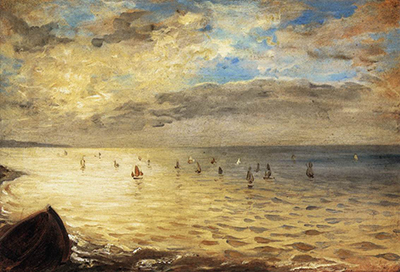The Sea from the Heights of Dieppe is a stunning seascape which perhaps reminds us more of other members of the Romanticist movement than it does Eugene Delacroix. He completed it in 1852, in oils on a small piece of cardboard, mounted on wood.
Eugene Delacroix was an artist who was able to paint classical items, but preferred in most cases to put his stamp on his career with new, expressive styles. He did produce landscapes and seascapes from time to time, as well as a number of stunning floral depictions, though these cannot be considered his main interest of work. The Sea from the Heights of Dieppe is certainly amongst his finest seascape paintings, but does not have the drama of many of his other paintings set at sea. There is a tranquil, calming vibe to this piece which again shows the versatility of this artist, even though this particular painting may not be considered as groundbreaking as his more famous works were. That said, there is a delightful handling of colour which reminds us of the later Impressionist movement, something that Delacroix may well have inspired through paintings such as this. It is important to remember that Monet's Impression, Sunrise appeared only two decades after this work was completed.
Perhaps in a similar way to how the Impressionists would later perfect their handling of natural conditions, Delacroix would endlessly practice his understanding and interpretation of skies and land across different times of the day, and within different climatic conditions. He also painted quickly, and expressively, which was another trademark of the Impressionist movement. They are known to have studied the work of Lorrain and Turner, but perhaps this painting also came to their attention as Delacroix was a particularly prominent artist who all within France were aware of at that time. Additionally, it again surprises us as to the depth of this artist's oeuvre, and his desire to constantly challenge himself, technically.
The artwork can now be found in the collection of the Louvre in Paris, though, as one of his lesser known pieces, may not always be out on display. They do have a number of other paintings which generally will be on show as part of their impressive collection of Romanticist art, always with a particular focus on native French art. This seascape was only 51cm wide by 35cm tall, meaning it could potentially be loaned out to other institutions fairly easily, so long as the insurance for doing so was put in place. This compares with some of the artist's other paintings which can be over three metres wide, making transportation a much more tricky endeavour. Besides the Romanticist work, you can also find the earlier Neo-Classicist work of Jacques Louis David well represented here too, and the highlights from his extensive career included The Death of Marat, The Oath of Horatii and Madame Recamier. He came before Delacroix and towards the end of his lifetime was seeing his style becoming less fashionable as new artists and movements took French art in another direction.




